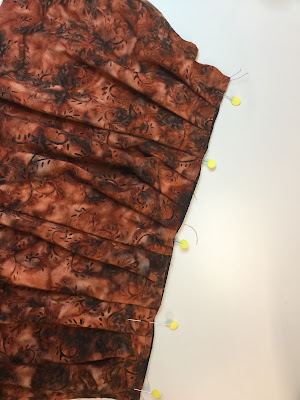Pattern -
Classic Oxford Button-Up from
Peek A Boo
Fabric - quilting cotton from Fabricland
Skills - buttons, button holes, hemming
I used to dread buttons! Especially on shirts that required a lot of those little shirt buttons. My hands would cramp up and it seemed to take forever to do. Finally I decided to try putting them on with my sewing machine - I do seem to take a while to come to these new-fangled ideas! Now I wouldn't put them on any other way.
So many people avoid shirts with buttonholes and buttons because the thought of sewing them is intimidating. It's actually so simple if your machine has the right stitches. If your sewing machine doesn't have automatic buttonholing and you're thinking of getting a new one, definitely go for a machine that has this capability. Quite inexpensive sewing machines have this capacity.
So lets get started! I like the way Peek A Boo does button up shirts. You do the buttons and buttonholes right off the bat when you're just dealing with 2 pieces of pattern. The first step is to turn and press the shirt fronts 1/4" and then 1". Then stitch down the front pieces 1" from the edge to secure the fold. I always stop a couple of inches from the bottom so I can neatly hide the hem in the shirt edge. It gives a cleaner finish. Now you're ready to do the buttonholes.
Buttonholes for males are on the left and for females on the right. Since this is for a boy, I'm putting them on the left. Start 2 1/2" from the top edge and mark it with a pin. The instructions say anywhere from 2" to 3" apart, so I spaced the rest of the buttonholes 2 1/2" apart.
I always practice on scrap first as I want to be sure I have the right setting for the buttons, so I made 2 buttonholes, one 15 mm and one 16 mm to see which would fit the buttons best. I cut them open using my seam ripper and after passing the button through each, decided that 15 mm was the best fit.
Just an aside here - I check out my local thrift store regularly as they remove buttons from unfit shirts and sell them separately. Decent shirt buttons are so hard to find and I get them very cheaply this way.
I line up the left front so that the edge of it is just peeking out the side of the buttonhole attachment and the needle is lined up at the pin, lower the foot and remove the pin - and away we go! Stitch all the buttonholes, then trim the loose thread and cut open the buttonholes.
Now it's time to sew on the buttons. For this part, I use an ordinary washable glue stick. Another way of securing the button is by putting a piece of tape over it and that's how I started, but as soon as I tried glue stick, I've done it this way ever since. And don't worry about getting glue on your needle. The glue is dry by the time you are ready to stitch and your needle stays clean.
Line the two fronts up side by side. Apply the glue stick to the back of each button and place it on the right side of the shirt front so that it's lined up with the middle of its buttonhole. Make sure that the holes in the button are square with the edge of the shirt.
My sewing machine has a button foot and a stitch for sewing on the buttons, but you can sew on the buttons without these. I'll address this at the end of the post. Since the buttons I'm using have 4 holes, I stitch diagonally - it's a much stronger stitch than just going horizontally or vertically. With the button stitch selected, I set the button in place and lower the needle so that it's in the left hand hole, then when I think I have the button lined up properly, I lower the foot. I always hand-wheel the first few stitches to make sure I have the button set up properly. Sew all the buttons on in this angle first and trim the loose threads.
Now we're ready to do the other angle. Just as before, line up the buttons, lower the needle, then the foot and sew. Trim the loose threads and you're done!
Then all you have to do is loosen the buttons so they're no longer glued in place and button up your front. Not the easiest to see with the fabric I was using, but the buttons and buttonholes are perfectly lined up and it only took a few minutes.
Now what if your machine doesn't have a stitch for sewing on buttons and you don't have a button foot? No problem! Remove the foot from the shank. Start with zig zag and a stitch width of 4. If you can select 0 for the stitch length, great. I can't on mine. Then lower the feed dogs so that the fabric isn't drawn through. Put the button in place and lower the needle to the left hand hole (or right if that's where your zig zag stitch starts).
Now gently lower the foot shank on to the button. It's precarious, but it should hold. Hand-wheel the first few stitches, and when you know you have the right stitch width selected, sew on the button. When you're finished sewing on the buttons, don't forget to raise the feed dogs! I started sewing on buttons without the button foot but as soon as I realized how great sewing on buttons by machine was, I went right out and ordered one. I'll bet after doing a set you'll be doing the same thing!














































